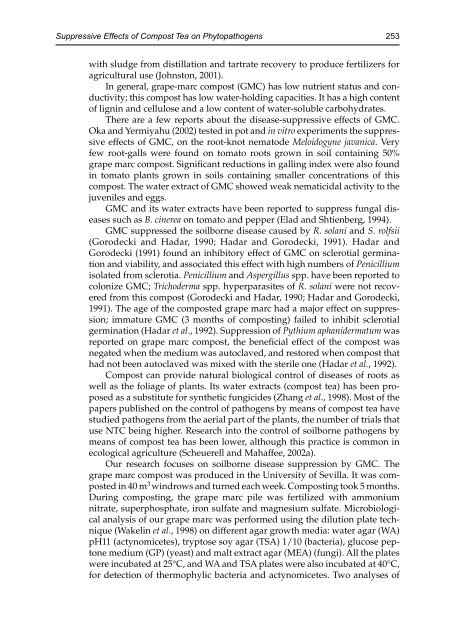natural-products-in-plant-pest-management
natural-products-in-plant-pest-management
natural-products-in-plant-pest-management
Create successful ePaper yourself
Turn your PDF publications into a flip-book with our unique Google optimized e-Paper software.
Suppressive Effects of Compost Tea on Phytopathogens 253with sludge from distillation and tartrate recovery to produce fertilizers foragricultural use (Johnston, 2001).In general, grape-marc compost (GMC) has low nutrient status and conductivity;this compost has low water-hold<strong>in</strong>g capacities. It has a high contentof lign<strong>in</strong> and cellulose and a low content of water-soluble carbohydrates.There are a few reports about the disease-suppressive effects of GMC.Oka and Yermiyahu (2002) tested <strong>in</strong> pot and <strong>in</strong> vitro experiments the suppressiveeffects of GMC, on the root-knot nematode Meloidogyne javanica. Veryfew root-galls were found on tomato roots grown <strong>in</strong> soil conta<strong>in</strong><strong>in</strong>g 50%grape marc compost. Significant reductions <strong>in</strong> gall<strong>in</strong>g <strong>in</strong>dex were also found<strong>in</strong> tomato <strong>plant</strong>s grown <strong>in</strong> soils conta<strong>in</strong><strong>in</strong>g smaller concentrations of thiscompost. The water extract of GMC showed weak nematicidal activity to thejuveniles and eggs.GMC and its water extracts have been reported to suppress fungal diseasessuch as B. c<strong>in</strong>erea on tomato and pepper (Elad and Shtienberg, 1994).GMC suppressed the soilborne disease caused by R. solani and S. rolfsii(Gorodecki and Hadar, 1990; Hadar and Gorodecki, 1991). Hadar andGorodecki (1991) found an <strong>in</strong>hibitory effect of GMC on sclerotial germ<strong>in</strong>ationand viability, and associated this effect with high numbers of Penicilliumisolated from sclerotia. Penicillium and Aspergillus spp. have been reported tocolonize GMC; Trichoderma spp. hyperparasites of R. solani were not recoveredfrom this compost (Gorodecki and Hadar, 1990; Hadar and Gorodecki,1991). The age of the composted grape marc had a major effect on suppression;immature GMC (3 months of compost<strong>in</strong>g) failed to <strong>in</strong>hibit sclerotialgerm<strong>in</strong>ation (Hadar et al., 1992). Suppression of Pythium aphanidermatum wasreported on grape marc compost, the beneficial effect of the compost wasnegated when the medium was autoclaved, and restored when compost thathad not been autoclaved was mixed with the sterile one (Hadar et al., 1992).Compost can provide <strong>natural</strong> biological control of diseases of roots aswell as the foliage of <strong>plant</strong>s. Its water extracts (compost tea) has been proposedas a substitute for synthetic fungicides (Zhang et al., 1998). Most of thepapers published on the control of pathogens by means of compost tea havestudied pathogens from the aerial part of the <strong>plant</strong>s, the number of trials thatuse NTC be<strong>in</strong>g higher. Research <strong>in</strong>to the control of soilborne pathogens bymeans of compost tea has been lower, although this practice is common <strong>in</strong>ecological agriculture (Scheuerell and Mahaffee, 2002a).Our research focuses on soilborne disease suppression by GMC. Thegrape marc compost was produced <strong>in</strong> the University of Sevilla. It was composted<strong>in</strong> 40 m 3 w<strong>in</strong>drows and turned each week. Compost<strong>in</strong>g took 5 months.Dur<strong>in</strong>g compost<strong>in</strong>g, the grape marc pile was fertilized with ammoniumnitrate, superphosphate, iron sulfate and magnesium sulfate. Microbiologicalanalysis of our grape marc was performed us<strong>in</strong>g the dilution plate technique(Wakel<strong>in</strong> et al., 1998) on different agar growth media: water agar (WA)pH11 (actynomicetes), tryptose soy agar (TSA) 1/10 (bacteria), glucose peptonemedium (GP) (yeast) and malt extract agar (MEA) (fungi). All the plateswere <strong>in</strong>cubated at 25°C, and WA and TSA plates were also <strong>in</strong>cubated at 40°C,for detection of thermophylic bacteria and actynomicetes. Two analyses of


